 Discover Perak (31 January, 2006)
Discover Perak (31 January, 2006)
B. Melayu
Map of Towns in Perak
Towns of Perak
- Ipoh - state capital (GPS: 4.60085, 101.07769)

- Kuala Kangsar - royal town (GPS: 4.77352, 100.94169)

- Ayer Tawar (GPS: 4.30002, 100.75904)

- Bagan Datoh (GPS: 3.99047, 100.78599)

- Bagan Panchor (GPS: 4.52521, 100.65343)

- Bagan Serai (GPS: 4.52521, 100.65343)

- Bandar Seri Iskandar (GPS: 4.35861, 100.9664)

- Batu Gajah (GPS: 4.47066, 101.04228)

- Batu Kurau (GPS: 4.97466, 100.79475)

- Behrang (GPS: 3.75596, 101.49963)

- Beruas (GPS: 4.49941, 100.78256)

- Bidor (GPS: 4.10982, 101.28725)

- Bota (GPS: 4.35051, 100.93122)

- Bota Kanan (GPS: 4.34843, 100.8828)

- Bukit Berapit (GPS: 5.74405, 101.02381)

- Bukit Berapit (GPS: 5.0328, 100.64901)

- Changkat Jering (GPS: 4.78729, 100.72154)

- Chemor (GPS: 4.71518, 101.12091)

- Chenderiang (GPS: 4.26475, 101.23798)

- Gerik (GPS: 5.42974, 101.12743)

- Gopeng (GPS: 4.47143, 101.16648)

- Jelapang (GPS: 4.63746, 101.05939)

- Jeram (GPS: 4.38654, 101.15567)

- Jerlun (GPS: 4.73242, 100.91268)

- Kampar (GPS: 4.30567, 101.15215)

- Kamunting (GPS: 4.88718, 100.7302)

- Kuala Gula (GPS: 4.93456, 100.46462)

- Kuala Kurau (GPS: 5.01724, 100.43083)

- Kuala Sepetang (GPS: 4.83809, 100.63008)

- Langkap (GPS: 4.0718, 101.14597)

- Lenggong (GPS: 5.10667, 100.96469)

- Lumut (GPS: 4.23514, 100.63167)

- Malim Nawar (GPS: 4.35803, 101.12185)

- Mambang Di Awan (GPS: 4.26734, 101.14774)

- Manong (GPS: 4.59404, 100.88024)

- Matang (GPS: 4.81816, 100.67356)

- Menglembu (GPS: 4.5659, 101.04752)

- Padang Rengas (GPS: 4.77565, 100.84773)

- Pangkor (GPS: 4.22555, 100.56138)

- Pantai Remis (GPS: 4.45441, 100.62978)

- Papan (GPS: 4.50814, 101.01757)

- Parit (GPS: 4.4758, 100.90856)

- Parit Buntar (GPS: 5.11864, 100.48679)

- Pasir Salak (GPS: 4.1367, 100.91182)

- Pengkalan Hulu (GPS: 5.70566, 100.99885)

- Proton City (GPS: 3.73596, 101.51079)

- Pusing (GPS: 4.49497, 101.0107)

- Sayong (GPS: 4.74358, 100.95972)

- Selama (GPS: 5.21745, 100.69227)

- Semanggol (GPS: 4.94986, 100.62944)

- Seri Manjung (GPS: 4.19482, 100.66446)

- Simpang (GPS: 4.81855, 100.70707)

- Simpang Pulai (GPS: 4.52872, 101.12816)

- Sitiawan (GPS: 4.21665, 100.69381)

- Slim River (GPS: 3.82897, 101.40243)

- Sungai Siput (GPS: 4.81936, 101.07593)

- Sungkai (GPS: 3.99971, 101.30664)

- Taiping (GPS: 4.85152, 100.74085)

- Tambun (GPS: 4.61372, 101.14382)

- Tanjung Malim (GPS: 3.70564, 101.50431)

- Tanjung Piandang (GPS: 5.07599, 100.3854)

- Tanjung Rambutan (GPS: 4.6627, 101.17395)

- Tanjung Tualang (GPS: 4.30241, 101.03988)

- Tapah (GPS: 4.19696, 101.25875)

- Teluk Intan (GPS: 4.02215, 101.02409)

- Terung (GPS: 4.70817, 100.71819)

- Trolak (GPS: 3.8908, 101.37805)

- Tronoh (GPS: 4.4224, 100.99147)

- Ulu Kinta (GPS: 4.63601, 101.14713)

Map of Perak Tourist Attractions
Sights in Perak
- Bota Kanan Tuntung Conservation Centre (GPS: 4.34927, 100.88027)

- Beruas Museum (GPS: 4.50125, 100.78023)

- Bukit Merah Laketown Resort
- Concubine Lane (GPS: 4.59632, 101.07794)

- Dutch Fort (GPS: 4.20046, 100.5761)

- Felda Residence Hot Springs
- Gua Kandu
- Gua Tambun (GPS: 4.41679, 101.18762)


- Gua Tempurung (GPS: 4.41679, 101.18762)

- Gunung Korbu (GPS: 4.68333, 101.29999)

- Istana Kenangan
- Istana Ulu
- Kellie's Castle (GPS: 4.47437, 101.08778)

- Kota Ngah Ibrahim
- Lata Iskandar Waterfall
- Lata Kinjang Waterfall
- Leaning Tower of Teluk Intan (GPS: 4.02523, 101.01934)

- Lenggong Archaeological Museum (GPS: 5.05462, 100.97396)

- Lost World of Tambun
- Matang Mangrove Forest Reserve (GPS: 4.83914, 100.63504)

- Maxwell Hill
- Pangkor
- Pasir Salak Historical Complex
- Perak Museum (GPS: 4.86016, 100.74553)

- Sam Poh Tong Temple (GPS: 4.5643, 101.1151)

- Segari Turtle Hatchery
- Sungkai Perak Wildlife and National Parks Department (GPS: 4.03232, 101.3693)

- Taiping Lake Gardens
- Taiping Zoo (GPS: 4.85491, 100.75142)

- Tanjung Tualang Tin Dredge (GPS: 4.39663, 101.05316)

- Ubudiah Royal Mosque (GPS: 4.76414, 100.95045)

Categories of Sights in Perak
- IPOH
- TOWNS IN PERAK
- Beaches in Perak
- Brethren Assemblies in Perak
- Bridges in Perak
- Bus Terminals in Perak
- Caves in Perak
- Cave Temples in Perak
- Cemeteries in Perak
- Chinese Temples in Perak
- Churches in Perak
- Clan Associations in Perak
- Clocktowers in Perak
- Dialysis Centres in Perak
- Forest Parks in Perak
- Forts in Perak
- Golf Courses in Perak
- Government Buildings in Perak
- Gurdwaras in Perak
- Hawker Centres in Perak
- Hills in Perak
- Hindu Temples in Perak
- Historic Buildings in Perak
- Hospitals in Perak
- Hotel Stays in Perak
- Hotels in Perak
- Islands in Perak
- Jetties in Perak
- Markets in Perak
- Mausoleums in Perak
- Monuments in Perak
- Mosques in Perak
- Mountains in Perak
- Museums in Perak
- Palaces in Perak
- Parks in Perak
- Petrol Stations in Perak
- Police Stations in Perak
- Recreation Clubs in Perak
- Restaurants in Perak
- Rivers in Perak
- Schools in Perak
- Shopping Malls in Perak
- Streets in Perak
- Swimming Pools in Perak
- Thai Temples in Perak
- Tourist Attractions in Perak
- Train Stations in Perak
- Universities in Perak
- Waterfalls in Perak
- Waterfront Promenades in Perak
Districts in Perak
About Perak
Perak is specially created to help people get to know Perak Darul Ridzuan. The name Perak Darul Ridzuan which means "Perak, the Land of Grace". It is one of the major states in Peninsular Malaysia. Perak has a land area of 21,000 sq km, making it the third largest state in Peninsular Malaysia after Pahang and Johor. The state of Perak is located between the main urban centres of Kuala Lumpur and Penang. Its capital, Ipoh, is becoming an increasingly vibrant city. Perak has a population of over 2 million people, making it one of the more densely populated states in the country. The state of Perak is divided into nine districts. Apart from the state capital Ipoh, major towns include Taiping, Kuala Kangsar, Kampar, Teluk Intan and Lumut. The Sultan of Perak is the constitutional state ruler residing in the royal town of Kuala Kangsar, approximately an hour from Ipoh.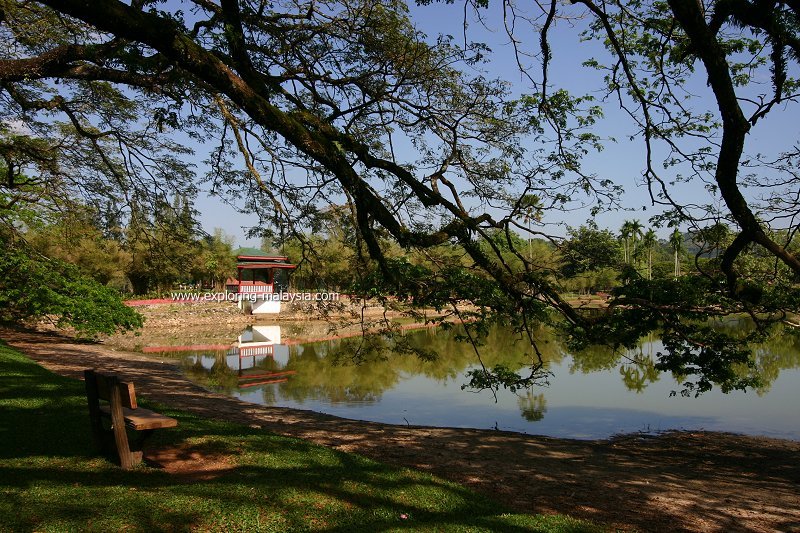 Taiping Lake Gardens (4 January 2006)
Taiping Lake Gardens (4 January 2006)
For centuries, the state of Perak is synonymous in Malaysia with tin mining. It is believed that the name of the state (Perak means silver, a misnomer for tin) came about because the word for tin appeared later than silver in the Malay language. According to another belief, the name was derived from the name of Tun Perak, the Bendahara (an archaic term for prime minister) of Malacca.
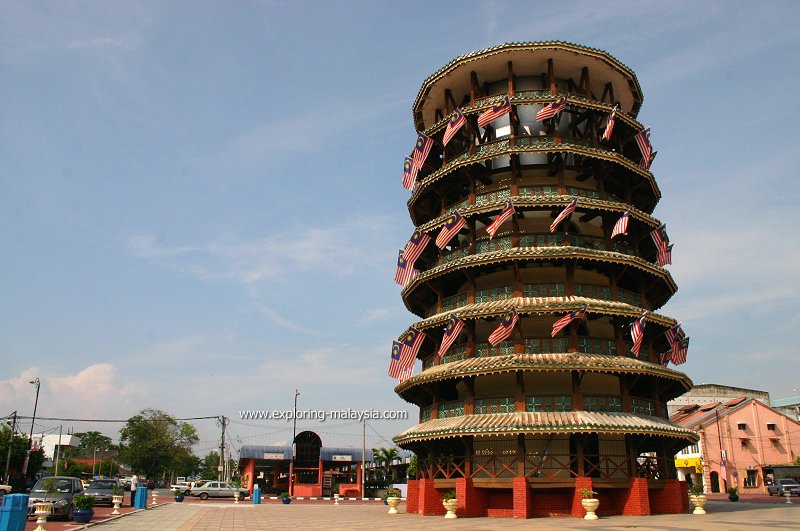 Leaning Tower of Teluk Intan (21 September 2004)
Leaning Tower of Teluk Intan (21 September 2004)
The Sultanate of Perak traces its roots to Sultan Muzaffar Shah, the eldest son of the last Sultan of Malacca. After the Sultanate of Malacca fell to the Portuguese in 1511, the Sultan of Malacca retreated to Johor, where he consolidated his power. His eldest son, however, chose to head north, and became the first Sultan of Perak in 1528. Perak is the only state in Malaysia whose royal house is descended directly from the Sultanate of Malacca.
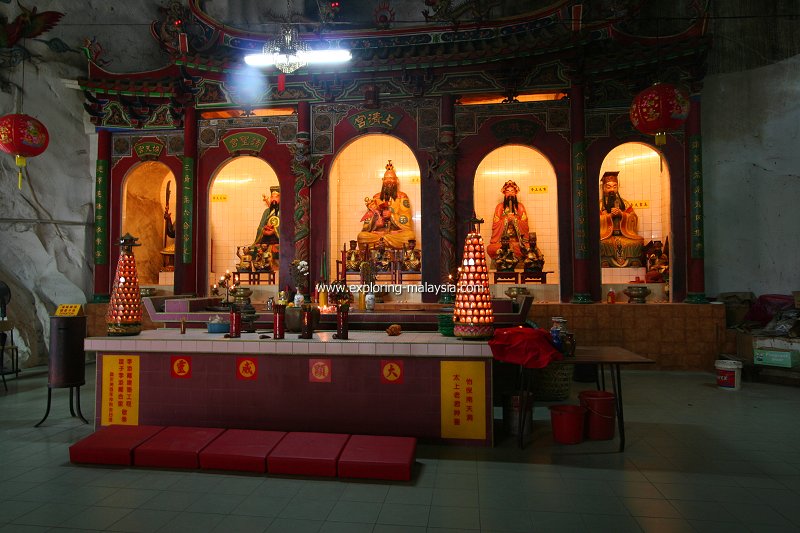 Cave Temple in Ipoh (19 August 2006)
Cave Temple in Ipoh (19 August 2006)
The state of Perak is named after its namesake river, just like Kelantan and Pahang. The capital was originally in Kuala Kangsar, until the discovery of huge quantity of tin led to the transfer of the capital, first to Taiping, and then finally to Ipoh. This wealth of tin deposit made Perak constantly under threat from foreign forces.
The Achinese from Sumatra raided the state in the 16th century. The town of Teluk Intan was founded by a woman from Mandailing, Sumatra. In 1641, the Dutch attempted to monopolise the tin trade of Perak by building a fort on Pangkor Island, at the mouth of the Perak River, but met with little success. In the 18th century, Perak had to withstand threats from the Bugis from the south and the Thais from the north.
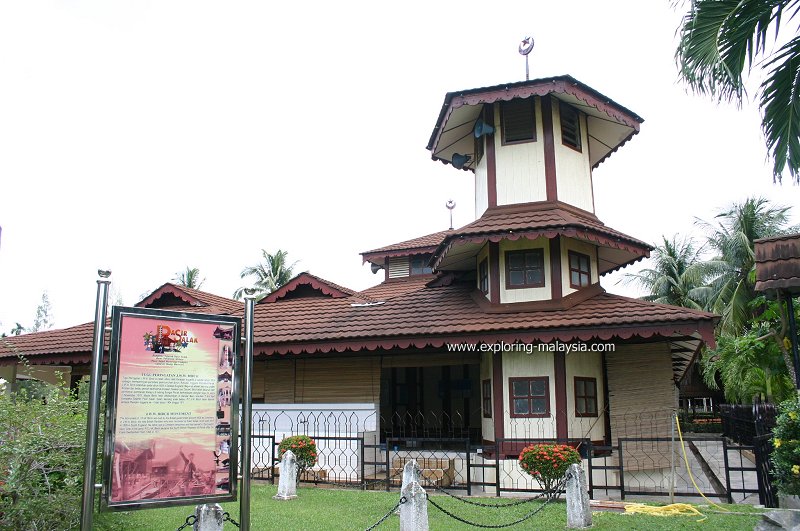 The mosque at Pasir Salak Historical Complex (21 September 2004)
The mosque at Pasir Salak Historical Complex (21 September 2004)
To work the tin mines, the Malay rulers brought in Chinese miners. This however lead to the destabilisation of the Malays. In the 1870s, succession dispute over the Perak throne and the gang-wars among the Chinese tin miners led to British intervention. They imposed the Pangkor Engagement and took control of the state, installing a British Resident in Perak who is the de facto ruler. However, opposition of the Perak Chiefs to Resident Birch resulted in his assassination at Pasir Salak, and a brief war.
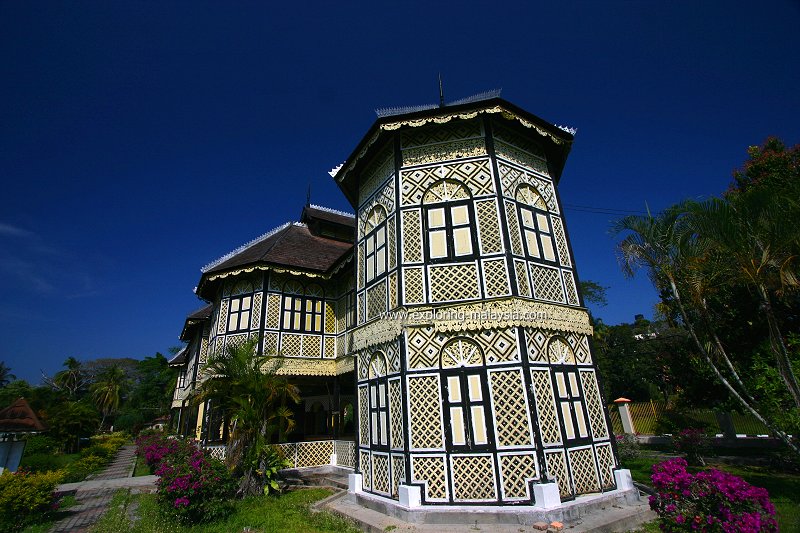 Istana Kenangan, Kuala Kangsar, Perak (31 January 2006)
Istana Kenangan, Kuala Kangsar, Perak (31 January 2006)
List of States in Malaysia
 Latest updates on Penang Travel Tips
Latest updates on Penang Travel Tips

Copyright © 2003-2025 Timothy Tye. All Rights Reserved.

 Go Back
Go Back